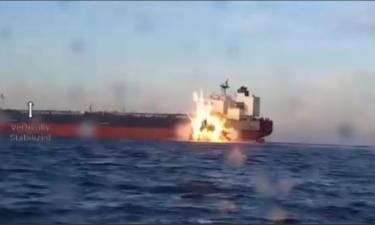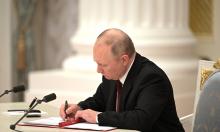Navalny poisoning: The most obscure story of the year
The US State Department blamed the Federal Security Bureau (FSB) of Russia for the attempt to poison opposition leader Alexei Navalny with the help of Novichok-class nerve agent.
"The United States believes that officers from the Russian Federal Security Service (FSB) used a Novichok nerve agent to poison Mr. Navalny. There is no plausible explanation for Mr. Navalny's poisoning other than Russian government involvement and responsibility," a State Department spokesperson said. "Of course, President Putin and the Russian government would have us believe otherwise."
Russia obviously highly likely behind Navalny poisoning
"Russia has suggested numerous, often contradictory, conspiracy theories. Let's be clear -- these types of conspiracy theories are nothing more than a means to deflect attention from the serious questions before the Russian government, which it has yet to answer," the spokesperson said.
The United States has "full confidence" in the findings of the Organization for the Prohibition of Chemical Weapons (OPCW), which confirmed the earlier findings by German, French and Swedish laboratories proving that Navalny was exposed to the Novichok nerve agent.
According to unconfirmed reports, the United States has prepared new sanctions against Russia in response to the Navalny case. However, in order to effect them, one needs to obtain approval from the entire American government and Donald Trump personally. It is worthy of note that Donald Trump has never blamed Russia specifically for poisoning Navalny. In addition, Trump cast doubts on Moscow's involvement in major cyberattacks on American government structures that took place a few days ago.
US Secretary of State Mike Pompeo said in September that the Russian administration could be behind Navalny's poisoning. The above-mentioned statement from the US State Department makes Moscow's involvement clear.
Russian President Putin stated at his annual press conference on December 17 that Navalny's investigation into the group of people who supposedly poisoned him was nothing but an act of "legalization of materials from American special services" with which Alexey Navalny is allegedly connected. Therefore, the Russian president said, Russian special services should "keep an eye on him." He also said that "if they really wanted to poison Navalny, they would have implemented the intention to the end, otherwise - who needs him?" Putin wondered.
The operation to poison Alexey Navalny was supposedly conducted by the group of at least eight FSB agents, members of the secret department operating under the cover of the FSB Institute of Forensic Science (aka NII-2 FSB or military unit 34435), the joint investigation by The Insider, Bellingcat, CNN and Der Spiegel said. The publications conducted their investigation with the participation of Alexey Navalny himself and the Anti-Corruption Foundation (FBK) that he chairs.
According to the official version, the main goal of NII-2 is to conduct expert examinations: the institute participated in investigations into all major events that Russia saw in its recent history. These included:
- the explosions of apartment buildings in 1999;
- the sinking of the Kursk submarine;
- the hostage crisis at the Moscow music threater;
- the hostage crisis in Beslan;
- the explosions in the St. Petersburg metro.
The FSB Institute of Forensic Science found elements of extremism in Yegor Zhukov videos and detected drugs in hair samples of journalist Ivan Golunov.
Former Soviet and Russian intelligence officers, who fled to the West, said the institute also runs a secret laboratory that used to make poisons during Soviet times. According to them, the polonium, with which former FSB officer Alexander Litvinenko was poisoned in London, was obtained from the institute.
Navalny's poisoners
Based on the billing of the phone numbers of 12 FSB officers associated with the Institute of Forensic Science, the investigators could allegedly confirm that NII-2 continues to run the chemical weapons laboratory, which is based in two secret and strictly guarded places: at AkademikaVargi Street in Moscow and in the complex of buildings near Moscow.
According to the journalists, the group of Navalny's poisoners consisted of former doctors and chemists. Three of them - people named Vladimir Panyaev, Alexey Frolov and Ivan Spiridonov - were on board the same flight with Navalny on August 13 en route from Moscow to Novosibirsk. They also booked a return flight to Moscow from Tomsk on August 21, but all the three individuals subsequently canceled their bookings.
Panyaev also flew to Kaliningrad on board the same flight with Alexei Navalny and his wife Yulia. Yulia suddenly became ill on the way to lunch. When the couple ordered food at a cafe, she realized that it was even hard for her to sit, Navalny wrote in his investigation. The woman felt better an hour later and was feeling "great" the next day. Navalny suggested that they either wanted to kill his wife, or she touched something that was intended for Navalny himself.
According to the investigators, the group includes:
- chemical scientist from the FSB Stanislav Makshakov;
- former doctor and coordinator of the group Oleg Tayakin ("Tarasov");
- former ER doctor and military doctor Alexey Alexandrov ("Frolov"), who is believed to be the key operative;
- Ivan Osipov ("Spiridonov");
- Konstantin Kudryavtsev ("Sokolov");
- Alexei Krivoshchekov, formerly an employee of the Ministry of Defense;
- Mikhail Shvets ("Stepanov"), registered at the FSB Special Operations Center in Balashikha;
- former FSB border service officer Vladimir Panyaev.
The analysis of the previous trips that the group had shows that they started following the oppositionist as early as in January 2017, after he announced his plans to take part in the presidential election in Russia in 2018. They followed Alexey Navalny in his 47 trips.
After Russia's Central Electoral Committee refused to register Navalny as a presidential candidate, surveillance was temporarily stopped. It resumed in full force in 2020. The analysis of the phone calls that the members of the group made using their regular phones showed two periods of particularly high activity - on the evening of August 16 and at night on August 19, which was just before the time when Navalny was poisoned.
According to The Insider, the poison was put in Alexey Navalny's underwear, which he had taken to the dry cleaner's, and part of the evidence was subsequently disposed of in Gorno-Altaysk. On August 25, after Navalny was taken to Berlin, Konstantin Kudryavtsev, a specialist in chemical weapons, flew to Omsk from Moscow for less than a day. Presumably, he took the oppositionist's belongings from the hospital.
Subscribe to Pravda.Ru Telegram channel, Facebook, RSS!




